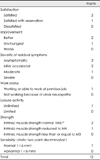Abstract
Objective
The purpose of this study is to present the efficacy of the surgical technique using a minimal skin incision for the treatment of cubital tunnel syndrome. Ulnar nerve entrapment at the elbow is the second most common compression neuropathy of the upper extremity. Surgical treatment of conventional simple decompression of ulnar nerve is considered to be relatively safe and reliable. However, this surgical technique is needed a relatively long incision and often can result in significant postoperative scarring and delay in return to work.
Methods
Ten patients with cubital tunnel syndrome underwent simple decompression using a 2 cm or less skin incision. According to Dellon's criteria, one elbow was classified as grade 1, four as grade 2, and five as grade 3. Preoperative electrodiagnostic studies were performed on all patients and 6 of them were rechecked postoperatively.
Results
Preoperative motor conduction velocity (MCV) within the segment was 35.5±16.2 m/s and decreased than the result of MCV in the below the elbow-wrist segment (59.3±5.9 m/s, p<0.05). Postoperative results of MCV were improved in all patients from 37.1±13.2 m/s to 51.9±8.9 m/s (p<0.05). After an average follow-up of 5.9±5.0 months, all patients were reported to be in good or excellent condition.
Figures and Tables
FIGURE 1
Skin marking at left elbow for simple decompression of ulnar nerve using a small incision. A 2 cm skin incision made between the medial epicondyle (E) and olecranon (O). Left side of photo is proximal.

FIGURE 2
Intraoperative photo shows the ulnar nerve (asterisk) and Osborne's ligament (black arrow).

FIGURE 3
The skin is retracted to distal side with a retractor. The released ulnar nerve (asterisk) and a head of flexor carpi ulnaris muscle (black arrow) are seen.

References
1. Bimmler D, Meyer VE. Surgical treatment of the ulnar nerve entrapment neuropathy: submuscular anterior transposition or simple decompression of the ulnar nerve? Long-term results in 79 cases. Ann Chir Main Memb Super. 1996; 15:148–157.
2. Butters K, Singer K. Nerve lesions of the arm and elbow. In : DeLee J, Drez D, editors. Orthopaedic sports medicine, principles and practice. Philadelphia: Saunders;1994. p. 802–811.
3. Campbell WW, Pridgeon RM, Sahni KS. Short segment incremental studies in the evaluation of ulnar neuropathy at the elbow. Muscle Nerve. 1992; 15:1050–1054.

4. Campbell WW, Pridgeon RM, Sahni SK. Entrapment neuropathy of the ulnar nerve at its point of exit from the flexor carpi ulnaris muscle. Muscle Nerve. 1988; 11:467–470.

5. Chan RC, Paine KW, Varughese G. Ulnar neuropathy at the elbow: comparison of simple decompression and anterior transposition. Neurosurgery. 1980; 7:545–550.
6. Cho YJ, Cho SM, Sheen SH, Choi JH, Huh DH, Song JH. Simple decompression of the ulnar nerve for cubital tunnel syndrome. J Korean Neurosurg Soc. 2007; 42:382–387.

7. Davies MA, Vonau M, Blum PW, Kwok BC, Matheson JM, Stening WA. Results of ulnar neuropathy at the elbow treated by decompression or anterior transposition. Aust N Z J Surg. 1991; 61:929–934.

8. Dellon AL. Review of treatment results for ulnar nerve entrapment at the elbow. J Hand Surg Am. 1989; 14:688–700.
9. Feindel W, Stratford J. Cubital tunnel compression in tardy ulnar palsy. Can Med Assoc J. 1958; 78:351–353.
10. Fernandez E, Pallini R, Lauretti L, Scogna A, La Marca F. Neurosurgery of the peripheral nervous system: cubital tunnel syndrome. Surg Neurol. 1998; 50:83–85.
11. Filippi R, Farag S, Reisch R, Grunert P, Böcher-Schwarz H. Cubital tunnel syndrome. Treatment by decompression without transposition of ulnar nerve. Minim Invasive Neurosurg. 2002; 45:164–168.

12. Gabel GT, Amadio PC. Reoperation for failed decompression of the ulnar nerve in the region of the elbow. J Bone Joint Surg Am. 1990; 72:213–219.

13. Gervasio O, Gambardella G, Zaccone C, Branca D. Simple decompression versus anterior submuscular transposition of the ulnar nerve in severe cubital tunnel syndrome: a prospective randomized study. Neurosurgery. 2005; 56:108–117. discussion 117.

14. Heithoff SJ. Cubital tunnel syndrome does not require transposition of the ulnar nerve. J Hand Surg Am. 1999; 24:898–905.

15. Hoffmann R, Siemionow M. The endoscopic management of cubital tunnel syndrome. J Hand Surg Br. 2006; 31:23–29.

16. Kanakamedala RV, Simons DG, Porter RW, Zucker RS. Ulnar nerve entrapment at the elbow localized by short segment stimulation. Arch Phys Med Rehabil. 1988; 69:959–963.
17. Kim JG, Lee KY, Yoo YR, Kim NK, Chung HY. Medial epicondylectomy for tardy ulnar palsy. J Korean Neurosurg Soc. 1974; 3:101–104.
18. Kleinman WB, Bishop AT. Anterior intramuscular transposition of the ulnar nerve. J Hand Surg Am. 1989; 14:972–979.

19. Mowlavi A, Andrews K, Lille S, Verhulst S, Zook EG, Milner S. The management of cubital tunnel syndrome: a meta-analysis of clinical studies. Plast Reconstr Surg. 2000; 106:327–334.

20. Muermans S, De Smet L. Partial medial epicondylectomy for cubital tunnel syndrome: outcome and complications. J Shoulder Elbow Surg. 2002; 11:248–252.

21. Nabhan A, Ahlhelm F, Kelm J, Reith W, Schwerdtfeger K, Steudel WI. Simple decompression or subcutaneous anterior transposition of the ulnar nerve for cubital tunnel syndrome. J Hand Surg Br. 2005; 30:521–524.

22. Nathan PA, Istvan JA, Meadows KD. Intermediate and long-term outcomes following simple decompression of the ulnar nerve at the elbow. Chir Main. 2005; 24:29–34.

23. Nathan PA, Keniston RC, Meadows KD. Outcome study of ulnar nerve compression at the elbow treated with simple decompression and an early programme of physical therapy. J Hand Surg Br. 1995; 20:628–637.

24. Nouhan R, Kleinert JM. Ulnar nerve decompression by transposing the nerve and Z-lengthening the flexor-pronator mass: clinical outcome. J Hand Surg Am. 1997; 22:127–131.

25. Olney RK, Miller RG. Conduction block in compression neuropathy: recognition and quantification. Muscle Nerve. 1984; 7:662–667.

26. Raynor EM, Shefner JM, Preston DC, Logigian EL. Sensory and mixed nerve conduction studies in the evaluation of ulnar neuropathy at the elbow. Muscle Nerve. 1994; 17:785–792.

27. Robertson C, Saratsiotis J. A review of compressive ulnar neuropathy at the elbow. J Manipulative Physiol Ther. 2005; 28:345.





 PDF
PDF ePub
ePub Citation
Citation Print
Print






 XML Download
XML Download